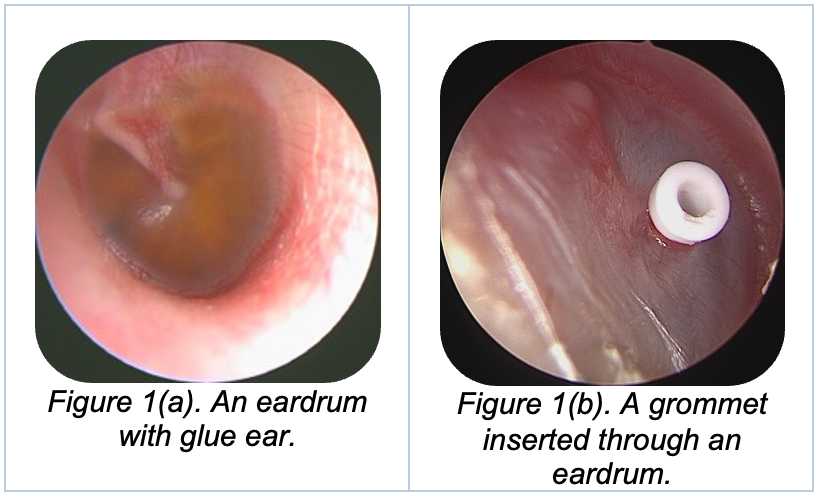Middle Ear Effusion
Middle ear effusion is common in children aged 1-6. Glue ear refers to the gluey consistency of the fluid that remains in the middle ear. The fluid can be gluey or straw-coloured yellowy fluid. Middle ear effusion can occur following episodes of acute otitis media or without acute inflammation due to other causes such as environmental factors, allergies, eustachian tube dysfunction, other anatomical obstructive causes.
Middle ear effusion causes impediment of sound wave transmission from the eardrum through the middle ear to the inner ear. Therefore the most common presentation is hearing loss associated with some ear pain, difficulty sleeping because of fullness in the ear, balance disturbance, irritability and occasionally fever. Middle ear effusion can get infected and during these episodes, children may have high fevers and severe pain associated with hearing loss. The primary treatment for middle ear effusions is a strong analgesic(pain killer) and occasionally antibiotics. Antibiotics do not routinely clear middle ear effusions unless they are infected.
Middle ear effusions are diagnosed clinically by your general practitioner or by your ENT surgeon. This is by visualising the eardrum which shows dullness lack of mobility and sometimes bulging. There may be changes to the eardrum with some scar tissue which is known as tympanosclerosis due to having had the fluid for some time. Another way of diagnosing middle ear effusion is by performing a Tympanometry or audiogram. Tympanometry is a very good tool to diagnose middle ear effusion as does not require a response from the child and is quick.
Middle ear effusions persisting for longer than 3 months require an ear nose and throat referral and often requires ventilation tube (grommets). Middle ear effusions do not normally respond to decongestant therapy nasal sprays and antihistamines. In children over 4 years of age having persistent middle ear effusions may also benefit from adenoidectomy as it has a beneficial effect in reducing recurrence of middle ear effusions. There are some benefits in resolving the effusions by keeping children away from daycare, reducing allergy and inflammation within the nose and nasopharyngeal cavity which may affect eustachian tube, and children performing eustachian tube exercises with various ear-popping demises devices such as Otovent and ear popper.
Grommets
Ventilation tubes known as Grommets are small PTFE blastic tubes of various sizes. They are inserted into the eardrum so it can drain the middle ear fluid at as another ventilation hole for the middle ear as the eustachian tube is not functioning well in these children. The tube acts as a drainage pathway as well as provides a port to equalise middle ear an outside pressure. The various types of grommets are shown below. Some grommets are 6mm in size and some up to 15mm. The actual hole varies from about 2mm to 10mm in size. Depending on the overall size of grommet and dice size of the side phalanges some grommets stay in for up to 9-12 months and the bigger ones tend to stay in for up to 5 years.

Grommets are inserted in children under a general anaesthetic. The general anaesthetic procedure is very short, approximately 15 minutes, and is performed by holding a mask ventilation on the child’s face to breathe oxygen and some anaesthetic agents. Children spontaneously breathe while the surgeon performs the grommet insertion surgery using a microscope making a very tiny perforation on the eardrum to release all of the fluid and suck all fluid out from the middle ear. The grommet is then placed in the middle of the eardrum. The procedure is a day stay procedure usually done in the morning and you will be in and out of the hospital within 3 hours. The child is normally back to normal and able to attend daycare or normal activities the next day. There may be some seepage of fluid over the next day or so if there was a significant amount of middle ear effusion at the time of surgery. The surgeon may provide you with some topical antibiotics drops to be placed in the ear canal to keep the grommet passage open and to wash away any of the seepage fluid. These antibiotic drops should only be used for a maximum of 5 days.




